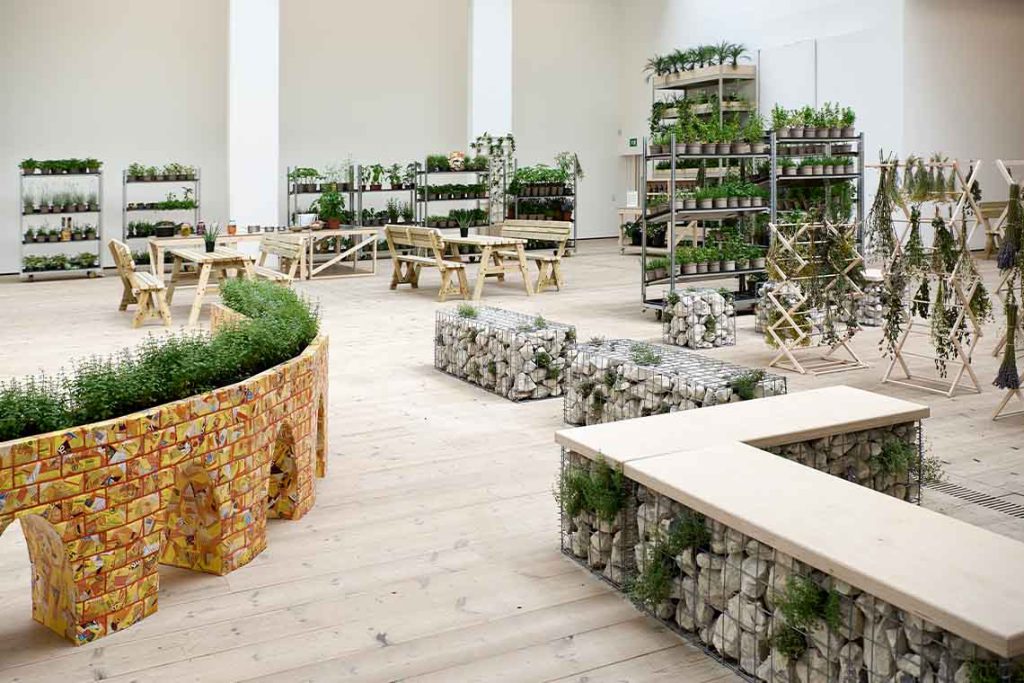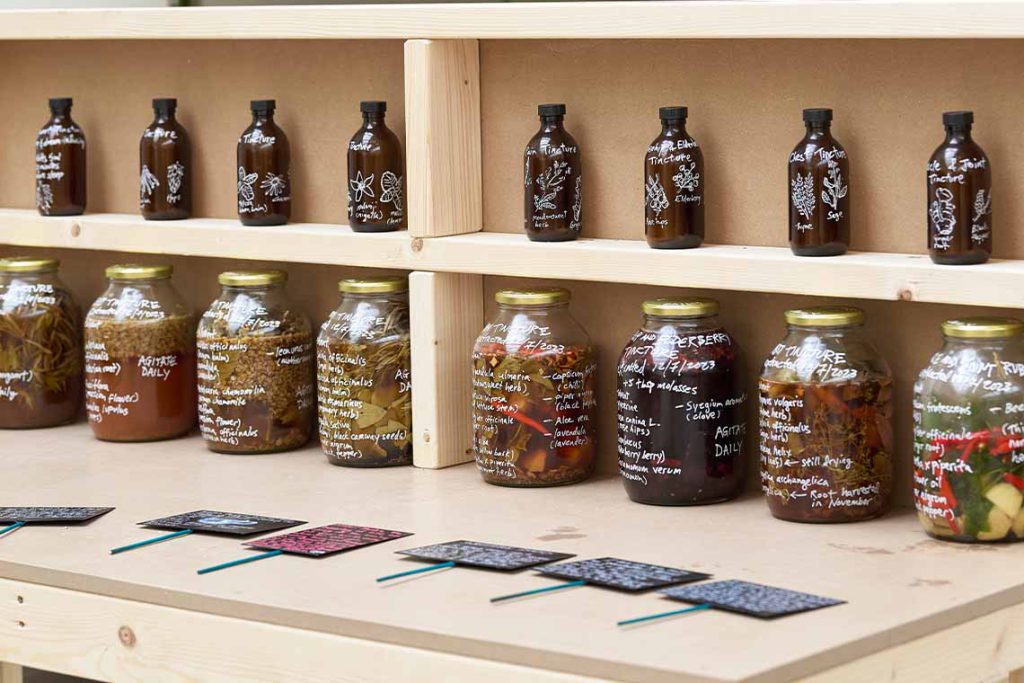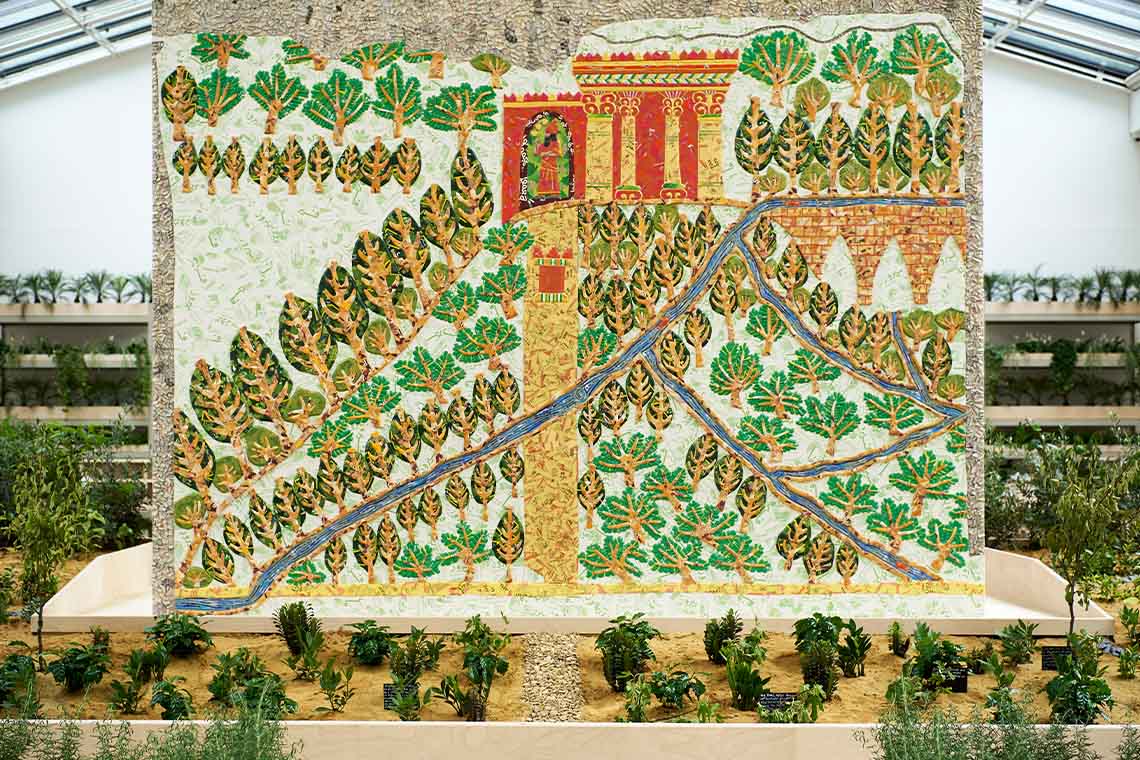Michael Rakowitz decks England’s Tyneside with a living installation, The Waiting Gardens of the North, celebrating the power of belonging and the quest for new horizons.
“The story goes that King Nebuchadnezzar built the Hanging Gardens of Babylon for his wife, Amytis, who was from Media in modern-day Iran and was homesick for the forested mountains that she left behind,” says artist Michael Rakowitz. “He created these terraces to mimic the mountains – a garden to cure homesickness.”
Far from Mesopotamia, on the southern bank of the River Tyne in northern England, Rakowitz has pioneered the birth of another such garden. Rather than an ancient queen, his Waiting Gardens of the North are built for – and with – local communities of refugees and asylum seekers.
Set on the fourth floor of Gateshead’s Baltic Centre for Contemporary Art and animated by the (often elusive) northern sun that streams through the (usually covered) glass roof, the gardens are anchored around a large, colourful replica of a stone relief housed in the British Museum since 1856. The relief depicts the Assyrian gardens in Nineveh in modern-day Iraq, which some scholars argue is the actual site of the legendary Hanging Gardens of Babylon. Out of this 2D visual centre flows a 3D living oasis; just as the relief, displaced from its home in Mosul, attests to both an uprootedness and a nostalgic idyll, so the plants in the Waiting Gardens carry their own stories of exile, loss and hope.
Olive trees, date palms, vines and vibrant red chillies are just some of the inhabitants of Baltic’s “suspended garden”, as Rakowitz describes it. While the show continues “dealing with [his] mother’s ancestral homelands of Mesopotamia” – the regional focus of much of the Iraqi- American artist’s work – the plants here have been selected by refugees from as far afield as Sri Lanka and Ukraine. Their familiar scents and growth patterns provide not only a tangible link to missed places and fond memories, but also to the land itself: “It’s about accessing memory through plants, and also about growing plants and understanding what the conditions are in their countries of origin,” says assistant curator Kinnari Saraiya.

In addition to providing a link to yearned-for homelands, the space – which is free to enter and designed for sitting and lingering – is a canvas and a quiet stage, through which local communities of refugees and asylum seekers can begin to share their own experiences. For Grace from Namibia, it is the green fleshy leaves of the Welwitschia plant, endemic to the Namib desert and known as a living fossil for its longevity, that provides a link to her homeland. Rakowitz recounts his plans to transport a seedling Welwitschia from Reading in southern England, in the hope that the plant “becomes a portal through which Grace can tell her and her family’s stories”.
Amid the plants and colourfully rendered captions – which include quotes and drawings from community members – nestle sculptures, made both by artists in Rakowitz’s studio and participants in Baltic’s “Language Cafe” sessions. “I invited them to make things that were either part of the British Museum’s inventory of objects from their homelands or things that they missed from their home countries, having had to depart from them,” explains the artist.
As with the relief that forms the centrepiece of the space, these objects are made from the packaging of foodstuffs used by many of the people who arrived in Newcastle and Gateshead seeking sanctuary. “I thought about the fact that an artefact holds its value because of provenance,” says Rakowitz of the packaging-clad artworks, telling Canvas how one participant chose to create an aeroplane. “She wanted to make the thing that she dreamed about going on as a kid, and then the aeroplane itself was what took her out of her home country and brought her to safety,” he recounts, reflecting on the complex histories of even inanimate objects, particularly where displacement is involved. The “completely organic” objects, made of “cardboard and potato glue”, will eventually become one with the plants. “The garden will take over,” says the artist.
The Waiting Gardens are not ornamental; they are to be harvested and “activated”, as Rakowitz terms it. Central to their activation are the space’s spice-grinding, tincture-distilling, cooking and tea-drying stations, which are hosting workshops, meals and gatherings across the show’s more than 10-month run. Visitors can enjoy daily tea tastings, while community groups host dinners, making use of the flavours found in the garden. “Many refugees are in hotels, where they don’t have kitchens, or the ability to host. […] Here they can come and plant, let things take root while they’re hoping to take root. And then they’re able to cook their food and share it – it becomes this real social space,” he says.

The gardens at Baltic – north-east England’s first Gallery of Sanctuary – have been realised in collaboration with a host of local organisations: the Comfrey Project, which works with refugees and asylum seekers on allotment sites across Newcastle and Gateshead; West End Refugee Service; Scotswood Garden community garden; Dilston Physic Garden; Herb Hub; and Baltic’s Language Café.
These “heroic organisations”, Rakowitz enthuses, inspired the artist to think about the role of museums and cultural institutions in providing sanctuary for refugees and asylum seekers.“We think about the 1954 Hague Convention that talked about the protection of cultural heritage during conflict…we have to think about those human communities also as cultural heritage,” he explains. With that in mind, he describes the “expectation of safety”inherent in a Gallery of Sanctuary, and the“irrevocable and irrefutable human rights that are afforded to the people who come through that door.”
While the olive seedlings, amaranth and sage will bloom, wither and change during the show’s run, the Waiting Gardens will take on new forms even after the space closes on 26 May 2024. The legacy of the exhibition will support local communities, organisations and schools through plants and other ongoing programmes, making “the footprint of this artwork bigger and bigger”; Rakowitz’s hope for the Gardens’ legacy, though, lies in the connections formed among its visitors. “What I hope will happen is encounters, that people will see someone they might not usually meet,” he says.
Just up the stairs from the Waiting Gardens is a viewing platform – overlooking the artwork on one side and the River Tyne, banked by Gateshead and Newcastle, on the other. “As you’re turning you see this other kind of city, built from the aggregation of people’s experiences, as a compost for other things to grow on,” the artist reflects, positing the possibility of “taking that prospective city and projecting it onto the landscape you see out of the window”.
The two cityscapes have something in common. The bridges crisscrossing the Tyne are a poignant illustration of the connections – metaphorical bridges – Rakowitz hopes are fostered in the Waiting Gardens. In this urban architectural reminder lies the realisation that “each person can be that bridge”.



